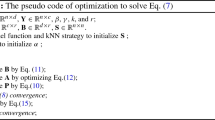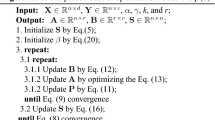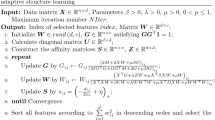Abstract
Unsupervised feature selection, aiming at finding a refined representation of the original data by filtering out irrelevant and redundant features, has attracted intensive attention. Due to the dilemma of unavailable labels, existing methods select relevant features that preserve the intrinsic structure of data. Despite they are proven effective, the fixed metric is utilized to measure the distances from the projected samples to the target representation in the reconstruction term, which means that existing methods can not possess sufficient flexibility to adapt to different types of data sources. Besides, conventional methods utilize the \(l_2\) norm based Laplacian graph to preserve the local structure of data, which leads to the sensitivity to noisy data. Inspired by the effectiveness and flexibility of the \(l_{2,p}\) norm metric, we propose adaptive unsupervised feature selection with robust graph regularization (AUFS). Specifically, we impose the \(l_{2,p}\) norm on the feature reconstruction term, which enhance the adaptability of our method to different types of data sources by adjusting p. In addition, \(l_{2,1}\) norm based Laplacian graph is designed to alleviate the negative impact of noisy data. To solve the optimization problem, a unified iterative algorithm with guaranteed convergence is proposed. A large number of experimental results on several benchmark datasets demonstrate that our method outperforms some latest and related methods.






Similar content being viewed by others
Data availability
Data will be made available on request.
References
Luo F, Zhang L, Du B, Zhang L (2020) Dimensionality reduction with enhanced hybrid-graph discriminant learning for hyperspectral image classification. IEEE Trans Geosci Remote Sens 58(8):5336–5353
Wong M, Hung C-C (2020) Dimensionality reduction with weighted k-means for hyperspectral image classification. In: IGARSS 2020-2020 IEEE International Geoscience and Remote Sensing Symposium, pp. 44–47
Chantar H, Mafarja M, Alsawalqah H, Heidari AA, Aljarah I, Faris H (2020) Feature selection using binary grey wolf optimizer with elite-based crossover for arabic text classification. Neural Comput Appl 32:12201–12220
Tang C, Liu X, Zhu X, Xiong J, Li M, Xia J, Wang X, Wang L (2019) Feature selective projection with low-rank embedding and dual laplacian regularization. IEEE Trans Knowl Data Eng 32(9):1747–1760
Zhang C, Fu H, Hu Q, Zhu P, Cao X (2017) Flexible multi-view dimensionality co-reduction. IEEE Trans Image Process 26(2):648–659
Lu J, Wang H, Zhou J, Chen Y, Lai Z, Hu Q (2021) Low-rank adaptive graph embedding for unsupervised feature extraction. Pattern Recogn 113:107758
Yang Z, Wan M, Zhan T, Lai Z, Luo L, Huang P, Zhang J (2018) Unsupervised multi-manifold linear differential projection (umldp) for face recognition. Multimed Tools Appl 77:3795–3811
Lai Z, Xu Y, Yang J, Shen L, Zhang D (2016) Rotational invariant dimensionality reduction algorithms. IEEE Trans Cybern 47(11):3733–3746
Lai Z, Chen X, Zhang J, Kong H, Wen J (2023) Maximal margin support vector machine for feature representation and classification. IEEE Trans Cybern 2:2
Shang R, Kong J, Feng J, Jiao L (2022) Feature selection via non-convex constraint and latent representation learning with laplacian embedding. Expert Syst Appl 208:118179
Shang R, Kong J, Zhang W, Feng J, Jiao L, Stolkin R (2022) Uncorrelated feature selection via sparse latent representation and extended olsda. Pattern Recogn 132:108966
Nematzadeh H, Enayatifar R, Mahmud M, Akbari E (2019) Frequency based feature selection method using whale algorithm. Genomics 111(6):1946–1955
Zhao Z, Liu H (2007) Spectral feature selection for supervised and unsupervised learning. In: Proceedings of the 24th International Conference on Machine Learning, pp. 1151–1157
Tabakhi S, Moradi P, Akhlaghian F (2014) An unsupervised feature selection algorithm based on ant colony optimization. Eng Appl Artif Intell 32:112–123
Zhang R, Li X (2020) Regularized regression with fuzzy membership embedding for unsupervised feature selection. IEEE Trans Fuzzy Syst 29(12):3743–3753
He X, Cai D, Niyogi P (2005) Laplacian score for feature selection. Adv Neural Inf Process Syst 18:507–514
Lin Q, Men M, Yang L, Zhong P (2022) A supervised multi-view feature selection method based on locally sparse regularization and block computing. Inf Sci 582:146–166
Lin Q, Yang L, Zhong P, Zou H (2021) Robust supervised multi-view feature selection with weighted shared loss and maximum margin criterion. Knowl-Based Syst 229:107331
Zhong J, Wang N, Lin Q, Zhong P (2019) Weighted feature selection via discriminative sparse multi-view learning. Knowl-Based Syst 178:132–148
Shi C, Gu Z, Duan C, Tian Q (2020) Multi-view adaptive semi-supervised feature selection with the self-paced learning. Signal Process 168:107332
Zhang H, Wu D, Nie F, Wang R, Li X (2021) Multilevel projections with adaptive neighbor graph for unsupervised multi-view feature selection. Inf Fusion 70:129–140
Cao Z, Xie X, Sun F, Qian J (2023) Consensus cluster structure guided multi-view unsupervised feature selection. Knowl-Based Syst 2:110578
Dong X, Zhu L, Song X, Li J, Cheng Z (2018) Adaptive collaborative similarity learning for unsupervised multi-view feature selection. In: International Joint Conference on Artificial Intelligence, pp. 2064–2070
Shang R, Zhang W, Lu M, Jiao L, Li Y (2022) Feature selection based on non-negative spectral feature learning and adaptive rank constraint. Knowl-Based Syst 236:107749
Zhu P, Hou X, Tang K, Liu Y, Zhao Y-P, Wang Z (2023) Unsupervised feature selection through combining graph learning and l2, 0-norm constraint. Inf Sci 622:68–82
Li X, Zhang H, Zhang R, Nie F (2019) Discriminative and uncorrelated feature selection with constrained spectral analysis in unsupervised learning. IEEE Trans Image Process 29:2139–2149
Lin X, Guan J, Chen B, Zeng Y (2021) Unsupervised feature selection via orthogonal basis clustering and local structure preserving. IEEE Trans Neural Netw Learn Syst 33(11):6881–6892
Luo C, Zheng J, Li T, Chen H, Huang Y, Peng X (2022) Orthogonally constrained matrix factorization for robust unsupervised feature selection with local preserving. Inf Sci 586:662–675
Liu Y, Ye D, Li W, Wang H, Gao Y (2020) Robust neighborhood embedding for unsupervised feature selection. Knowl-Based Syst 193:105462
Zhang M, Yang Y, Zhang H, Shen F, Zhang D (2016) L2, p-norm and sample constraint based feature selection and classification for ad diagnosis. Neurocomputing 195:104–111
Kodirov E, Xiang T, Fu Z, Gong S (2016) Learning robust graph regularisation for subspace clustering. In: BMVC, pp. 138–113812
Tang C, Zhu X, Chen J, Wang P, Liu X, Tian J (2018) Robust graph regularized unsupervised feature selection. Expert Syst Appl 96:64–76
Li X, Zhang H, Zhang R, Liu Y, Nie F (2018) Generalized uncorrelated regression with adaptive graph for unsupervised feature selection. IEEE Trans Neural Netw Learn Syst 30(5):1587–1595
Huang Y, Shen Z, Cai F, Li T, Lv F (2021) Adaptive graph-based generalized regression model for unsupervised feature selection. Knowl-Based Syst 227:107156
Cai D, Zhang C, He X (2010) Unsupervised feature selection for multi-cluster data. In: Proceedings of the 16th ACM SIGKDD International Conference on Knowledge Discovery and Data Mining, pp. 333–342
Zhu P, Zhu W, Hu Q, Zhang C, Zuo W (2017) Subspace clustering guided unsupervised feature selection. Pattern Recogn 66:364–374
Zhu P, Zuo W, Zhang L, Hu Q, Shiu SC (2015) Unsupervised feature selection by regularized self-representation. Pattern Recogn 48(2):438–446
Tang C, Bian M, Liu X, Li M, Zhou H, Wang P, Yin H (2019) Unsupervised feature selection via latent representation learning and manifold regularization. Neural Netw 117:163–178
Shang R, Wang L, Shang F, Jiao L, Li Y (2021) Dual space latent representation learning for unsupervised feature selection. Pattern Recogn 114:107873
Nie F, Zhu W, Li X (2019) Structured graph optimization for unsupervised feature selection. IEEE Trans Knowl Data Eng 33(3):1210–1222
Han D, Kim J (2015) Unsupervised simultaneous orthogonal basis clustering feature selection. In: Proceedings of the IEEE Conference on Computer Vision and Pattern Recognition, pp. 5016–5023
Liu X, Wang L, Zhang J, Yin J, Liu H (2013) Global and local structure preservation for feature selection. IEEE Trans Neural Netw Learn Syst 25(6):1083–1095
Nie F, Zhu W, Li X (2016) Unsupervised feature selection with structured graph optimization. In: Proceedings of the AAAI Conference on Artificial Intelligence, vol. 30, pp. 1302–1308
Parsa MG, Zare H, Ghatee M (2020) Unsupervised feature selection based on adaptive similarity learning and subspace clustering. Eng Appl Artif Intell 95:25
Wang S, Xiao S, Zhu W, Guo Y (2022) Multi-view fuzzy clustering of deep random walk and sparse low-rank embedding. Inf Sci 586:224–238
Acknowledgements
This work is supported by National Natural Science Foundation of China (No. 61906101).
Author information
Authors and Affiliations
Corresponding author
Additional information
Publisher's Note
Springer Nature remains neutral with regard to jurisdictional claims in published maps and institutional affiliations.
Rights and permissions
Springer Nature or its licensor (e.g. a society or other partner) holds exclusive rights to this article under a publishing agreement with the author(s) or other rightsholder(s); author self-archiving of the accepted manuscript version of this article is solely governed by the terms of such publishing agreement and applicable law.
About this article
Cite this article
Cao, Z., Xie, X. & Sun, F. Adaptive unsupervised feature selection with robust graph regularization. Int. J. Mach. Learn. & Cyber. 15, 341–354 (2024). https://doi.org/10.1007/s13042-023-01912-8
Received:
Accepted:
Published:
Issue Date:
DOI: https://doi.org/10.1007/s13042-023-01912-8




